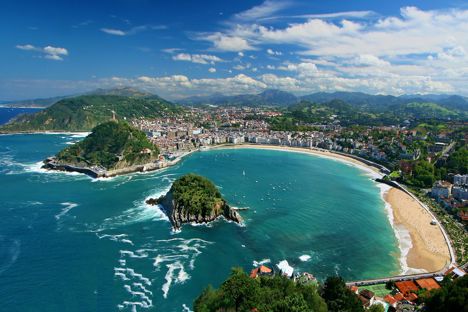
San Sebastián: the food capital of Spain
We visit stunning San Sebastián, one of the world’s most exciting gastronomic destinations.
San Sebastián: the food capital of Spain
We visit stunning San Sebastián, one of the world’s most exciting gastronomic destinations.
One of the first things that strikes any visitor to the city of San Sebastián (or Donostia in Basque) is how jaw droppingly beautiful it is. Facing directly onto a sheltered bay, its beaches and setting are possibly rivalled only by Rio de Janeiro in Brazil. The city as a holiday destination for well-heeled Spaniards, really got going when King Alfonso XIII’s widow Queen Maria Christina set up her summer residence at the Miramar Palace in 1885, bringing the Spanish court with her. With the arrival of World War One, San Sebastián became one of the most cosmopolitan cities in Europe. People like Leon Trotsky, Mata Hari and Maurice Ravel all spent time there, and wandering about the city today with its well-maintained Belle Époque buildings you wouldn’t be surprised to bump into some of them now.
Despite hosting Spain’s most important film festival, a reflection of the glitz and glamour of old, the real reason San Sebastián is famous throughout the world is its food. If you stand at the mayoral buildings in the centre of town, there are restaurants with a total of nineteen Michelin stars within a radius of twenty-five kilometres, three of them with three stars each. Only Kyoto in Japan has more Michelin star restaurants per square kilometre.
All of this Michelin glory is really only possible because of how seriously Donostiarras - as the inhabitants of San Sebastián are known - and those in the wider province of Guipúzcoa, take their food. People expect quality produce and they expect to pay a fair price for it. Cooking and eating is regarded as a way of life and an expression of both culture and identity. Donostiarras view their top restaurants as expressions of art and their top chefs as important cultural figures rather than mere celebrities; people save up for months to go to the better restaurants in the province. Everyday shops and markets stock a wide range of top-quality seasonal fruit, vegetables, meat and fish - the whole city breathes good food.
For anyone visiting San Sebastián, the first thing you need to do is eat pinchos (pintxos in Basque). Small pieces of bread are loaded with all kinds of food - cold slices of Serrano ham, quail’s egg and piquillo pepper, anchovies with tiny, chopped vegetables. Traditionally, these are fixed with a large cocktail-like stick (called a pintxo in Basque) and served with small glasses of beer or wine, or a couple of fingers of cider. This is not a meal; this is an aperitif. If you are drinking wine then this is el Txikiteo, which translates along the lines of ‘the wine drinking’ in English. The measures are really small and the Donostiarra practice is to meet friends, have a pincho and a small glass in one bar and then move to the next one or two bars before going on further to the main event of a meal at home or in a restaurant. The idea is that you have a ‘quick one’ (or two) socialising in a big group before having a sit-down meal with family. The old part of San Sebastián has pincho bars packed together and you can just move on from one to another in the same street, looking at their menu boards for specialties. It is one of the best ways to socialise and at the same time to eat a variety of delicious food from different places.
When you are ready to sit down for a proper meal, you are guaranteed seasonal local produce because the locals wouldn’t accept anything else. The traditional Basque flavourings of garlic, parsley and guindilla pepper are often to be found in dishes like kokotxas (hake cheeks), marmitako (tuna and potato stew) and sulkalki (beef stew with potatoes). No one knows more about cooking directly on fire grills than the Basques, and specialist grill restaurants will serve perfectly cooked fish, meat and vegetables in ways that will make you wonder if they managed to learn the secrets of fire directly from the Gods.
Arzak: The restaurant that Jose Mari Arzak inherited from his mother and turned into a three-Michelin-starred establishment is now run by his equally capable daughter Elena, and is one of the must-dos of the province if you have been saving up for an unforgettable culinary experience.
Sidreria Saizar: About ten minutes drive outside of San Sebastián this is one of the biggest cider houses in Gipuzkoa. You can get a tour of the production process, drink cider (little and often) straight from the barrel and have traditional Basque dishes like huge T-bone steaks and wild mushrooms in season, all cooked on a wood fired grill. Vegetarian and vegan menus are available.
Casa Urola: Opened in 1956 in the middle of the old part of San Sebastián, Urola is an institution in these parts, serving updated seasonal classics like roast pigeon with chestnut purée, hake cheeks grilled or in pil-pil sauce, or a selection of pintxos at the bar.
Elkano: Fifteen miles from San Sebastián, Elkano is currently sixteen on the list of the prestigious 50 Best Restaurants and has one Michelin star. Founded by his father Pedro, Aitor Arregui has mastered the traditional Basque grill like no one else in the region. Chefs the world over come and eat at Elkano and they try to get a backstage view of the cooking process to see what they can learn.


